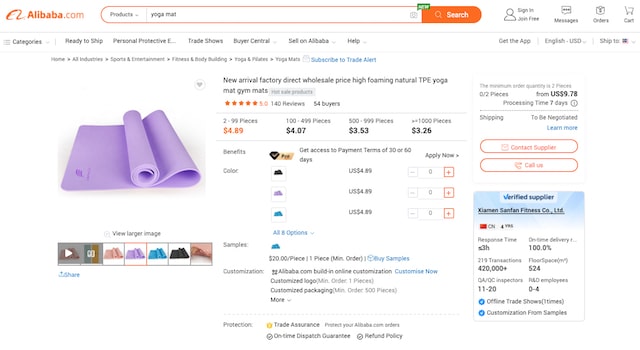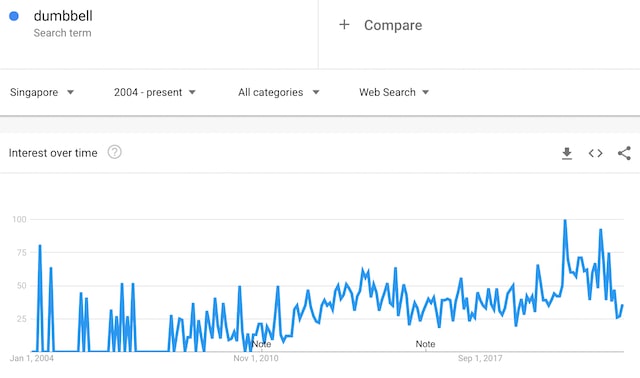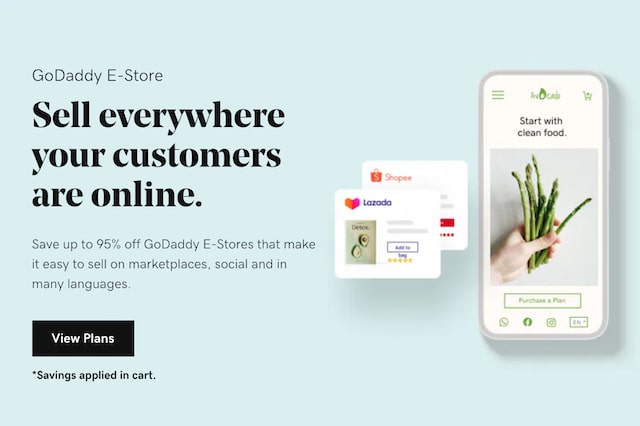This post was originally published on Feb. 10, 2022, and was updated on Jan. 31, 2023 and Feb 1, 2024.
Launching your own online store is a great way to reach a wide audience and sell your products. However, starting an online selling business can be overwhelming, especially if you don't know where to begin. That's why we've created this comprehensive beginner’s guide to help you start selling online. From finding your niche to setting up your online store, this guide will walk you through all the steps necessary to establish your online business. We will also cover the advantages and disadvantages of online selling, as well as some of the legal requirements you'll need to comply with.
Whether you're an aspiring entrepreneur or a small business owner looking to expand your reach, this guide will provide you with the information you need to get started.
So don't wait any longer, let's start building your successful online business today!
How is online selling thriving in the new normal?
The pandemic has changed the way we shop and do business. As most of us had to stay home for extended periods of time, online shopping and selling rose dramatically.
This shift to online commerce has created new opportunities for entrepreneurs to start their own businesses and reach a much wider audience than before.
In both South East Asia and Hong Kong, e-commerce spending has increased dramatically since the pandemic started. The region that includes Singapore, Malaysia, and The Philippines has added 70 million new online shoppers. While in Hong Kong, the percentage of those who shop online is expected to grow from 73% to over 83% by 2025.
Gone are the days where selling something meant that you need a physical store. With the help of new technologies and its rapid advancement, the world of e-commerce and selling online is booming. But how can you take advantage of this trend? Let’s get started with everything you need to know to start your online selling business!
Step-by-Step guide to selling online
Starting an online selling business is not as daunting a task as it might seem. With the right guidance and resources, anyone can become an e-commerce entrepreneur. To help you get started, here's our step-by-step guide to launching your online store.
1. Research and find your niche
Before you start selling online, it's important to have a clear idea of what you want to sell and who your target market is. This involves researching your niche, analyzing market trends, and understanding the needs and desires of your potential customers.
Finding your niche can be a fun and rewarding process. One way is to start by thinking about your interests, hobbies, and passions. What do you love to talk about or learn about? What problems or challenges do you have experience solving? These are all great starting points for finding your niche and potential product ideas.
Next, do some research to see if there is demand for a certain type of product or service in your chosen niche. Look for industry reports, trends, and customer feedback to get a sense of what people are looking for. You can also use tools like Google's Keyword Planner to see how many people are searching for specific terms related to your niche.
Finally, consider your target audience. Who are the people you want to sell to? What are their needs and wants?
Understanding your target audience will help you create e-commerce marketing messages that resonate with them and find the right channels to sell through.
Editor’s note: Start selling online even if you’re not a pro with GoDaddy Online Store!
What to sell? Selecting products
Now that you have a clear idea of your niche and target audience, it's time to choose your products! This is where you get to let your creativity and passion shine. When selecting products to sell, consider factors like whether the product solves a problem, follows your passion, has branding potential, and fits with market trends. Don't be afraid to think outside the box and come up with unique products or services that stand out.
Factors to consider while choosing a product to sell
When selecting products to sell, there are several important factors to consider:
Select a product that solves a problem:
The best products are those that solve a problem or meet a need. Think about what people in your target audience might be looking for and how you can provide them with the solution.
For example, if you're targeting busy parents, perhaps you could sell products that make parenting easier or save time. Or if your niche is eco-friendly living, you could sell products that help people reduce their environmental impact.

Think about how your product or service can make life easier and create content to explain the benefits of your offering. This is a great way to show potential customers why your product is worth investing in.
Follow your passion:
If you're passionate about a certain product or service, consider selling it as part of your online store. Not only will this ensure that you enjoy running your business and stay motivated, but it can also be an effective way to stand out from the competition and build a strong brand.
For example, if you love yoga and have experience teaching it, you could sell yoga classes as part of your online store. Or if you're an expert baker, you could offer baking lessons and recipe guides.
By following your passion and offering something unique, you can create a strong brand that resonates with customers and sets you apart from the competition.
Analyze the product or service from the customer's point of view:
When considering a product or service, think about it from the customer's point of view. What will your product do for them? Why should they choose you over another supplier? What makes your product different from those already on the market?
Also consider factors like cost, quality, delivery time, packaging, and customer service. These are all important elements that will impact the customer experience and determine whether they'll buy from you. How well you execute these factors will also determine how many repeat customers you gain.
Taking the time to understand how your product appears from a customer's perspective is really helpful when designing useful solutions. By focusing on this, you can craft a winning business idea that delivers on customers' needs.
Find a product with branding potential:
If you want your business to stand out, look for products or services that have the potential to build a brand around them. This could be a product that is unique, high-quality, or has a strong visual appeal. It can also come in the form of a catchy name, interesting design, or unique logo and packaging.
Branding can also be a very important factor in building customer loyalty and attracting repeat business. Think about how you can use visuals to make a statement and differentiate your product from the rest. Consider investing time in developing creative branding and packaging that represent your business.
Finding products with branding potential can also help you create consistent messaging across different platforms and campaigns. This could include product pages, product descriptions, social media marketing, Google ads, and more. This consistency will make it much easier for people to recognize your brand.
Consider market trends:
It's important to keep an eye on markets and industry trends when selecting products. Monitor customer behavior across different channels, such as social media platforms and email marketing campaigns, to get a better understanding of what people are looking for.
Also, consider new product launches in your niche and how they could offer potential opportunities for you. Always be open-minded and willing to explore new ideas, as this can help you stay ahead of the competition.
Continuously researching market trends can help you better understand what customers want and give you fresh ideas for products or services that you can offer. This will ensure that your online store remains relevant, attractive to customers, and able to generate sales.
A beginner’s guide to start selling online
In this beginner’s guide, we’ll cover tips and tricks to help you get started making your first sale online. From knowing what to sell, finding suppliers, and choosing the right mix of online channels for your online store.
Here is what we’ll cover:
- What to sell
- Sourcing products for your online business
- Figuring out what items are popular locally
- Starting out small
- Doing market research
- Knowing both your customer and the competition
- Choosing the right channels to sell on (website, social media, marketplaces, etc.)
Keep in mind, there’s a lot to learn when starting an online selling business. Before jumping into the e-commerce space, soak in as much relevant information as you can. Understanding topics like marketing, SEO, and customer support are essential. Also, don’t skip over creating a business plan and learning how to register your business.
Related: Small business plan help and tips for new entrepreneurs
WHAT to sell?
When it comes to selling online, perhaps the number one consideration is what to sell. Because you may have the fanciest online store in the world. But if nobody wants the products you offer, it’s unlikely you’ll achieve the online retail sales you hoped for. On the other hand, by figuring out what people are looking to buy, you’ll position your online store for success.
Know your supply chain
Before you start selling online, you’ll need to know where to find great products to sell. This is your supply chain. A supply chain is made up of the manufacturers, wholesalers, or distributors of your merchandise. If you plan to sell your own hand-crafted items, you will mainly focus on sourcing raw materials. Otherwise, you’ll need to find suppliers for those products. Let’s go over the most common options to source products and start selling online:
Buy inventory from a wholesaler
Rather than producing all of their own items, most retail stores instead rely on wholesalers and distributors. These companies provide merchandise to re-sell. Because wholesale products are typically sold in larger quantities, they are usually sold at discounted, wholesale pricing.
There are many popular platforms for finding wholesalers, especially for products coming from China. These include websites like Alibaba, Chinabrands, and DHGate. To get started finding wholesale products, head to one of these platforms and start browsing. Or, just type in what you are looking for on these business websites.

You’ll also be able to see important information about the manufacturer. This is helpful when deciding which supplier you’d like to order from. Ultimately, you want to sell a great product at the best price to your customers!
These platforms are great for imported products. But keep in mind, to start selling online, the best supplier for your business may be a local company.
Use the dropshipping model
Dropshipping is a popular method to start selling online. This is where your online store doesn’t actually hold any inventory. Once customers place an order through your website, you place an order with your supplier. The supplier will then ship the product directly to the customer.
The benefits of dropshipping are that you don’t need to invest in inventory beforehand. Therefore, you can list many items for sale on your website without needing to know exactly which items to carry and in what quantity. This can reduce how much money you need upfront. It can be great for small business owners who want to start an online selling business with less capital.
However, there are potential downsides to dropshipping as well. For instance, you’ll need to trust that your supplier has inventory in stock. Otherwise, you might accept payment for a customer’s order, only to find out later that the item is out of stock. Without owning your own inventory, you give up some control over your online business.
Create your own crafts or handmade items
If you plan to start selling online with handmade items like art or crafts, you won’t be buying finished products from a supplier. However, you will still need to consider how to get a hold of the necessary raw materials.
For instance, if you sell handmade jewellery, where will you source the metals, gems, or other materials you need to fashion these items?
Sell digital products
Finally, don’t think that to start selling online, you must sell physical products. The best products for your online business may be digital products. These include downloadable or streamable items like ebooks, software, and online courses.
Here are a few examples of digital products you can start selling online:
- Ebooks for exercise or diet
- Custom WordPress templates
- Online courses on business or hobby topics
No matter what kind of products you decide to sell, it’s important to understand your supply chain.
This includes finding suppliers that provide high-quality products at competitive rates. For extra peace of mind, consider securing backup suppliers. This will help protect your business from disruption. For example, if supplier A becomes unable to deliver, you can still get your merchandise from supplier B or C.
Related: 5 side hustle ideas that can make you money from home
Know what’s popular in your locale
Winter skiing clothing and accessories are popular in Canada and France. But will they be big sellers in your local market? It’s likely they may be more of a niche item – which is not necessarily a bad thing! Before you start an online selling business, figure out how much demand there is for a product in your region. How do you find out what’s popular locally? You’ll need to roll up your sleeves and do some research. We start covering research in the next section!
Starting small
There’s one more thing to understand at this point.
Then, once you see that your customers are buying a particular item, you can order more.
If you are dropshipping, buying inventory isn’t relevant to your business model. But, it would be wise to apply this mindset to all aspects of your online business.
Across your business, start small. Test the waters. Then, increase your spending and effort once you see results.
Editor’s note: Need an easy to set up yet powerful E-commerce site? Head over to GoDaddy’s E-Store and start creating your online store today!
HOW to sell? Doing Market Research
Market research is the real key to knowing not only what to sell, but how, and to whom. This research can be highly scientific and detailed. But it can also refer to hopping on Google or heading out to your local shopping centre.
Before you start an online selling business, there are a few types of market research you should perform:
- Keyword research
- Customer research
- Competition analysis
- Trendspotting
- Using social media
This research shouldn’t be thought of as optional. It’s actually a crucial step in launching any e-commerce store. As small business owners, we may think we know exactly what customers want. But you shouldn’t base a business on assumptions. Instead, let research guide your decisions. Who knows, you might be able to find some niche products for an underserved group of customers!
When doing research, don’t just look at your target customer. Seek to understand the entire market including your competition.
Keyword Research
Keyword research helps uncover if a particular product is in demand. Whether you should sell it online depends on many other factors, including how competitive the market is. But it’s a good starting point to know how many people are searching for that item.
Both free and paid keyword research tools are available online. Free tools include Google’s Keyword Planner and Keyword Tool among many others. Paid tools with limited, but useful free plans include Semrush’s Keyword Overview. Tools like Ubersuggest also provide blog post ideas based on your keyword. This can be very helpful when trying to boost your search engine optimization (SEO) rankings.
Also, don’t forget about plain old Google. Enter a product or keyword into Google’s search field and see what websites are returned. Are the results mostly large e-commerce stores that will be difficult to compete with? Or, do you think there will be room for your own e-commerce site?
When researching product ideas, look for keywords with high interest, but without intense competition. Too much competition will make it difficult to rank. But a lack of competition may signal weak customer interest in that product.
To gain a broad view of a keyword’s popularity in your region over time, head over to Google Trends. In the data below, we can see that the keyword dumbbell has grown steadily in Singapore since 2004. Notice that interest spiked in April 2020 at the start of the pandemic.

Related: Four actionable SEO techniques for your website
Know your customers
There’s a misconception among some who hope to start selling online. It’s the idea that all you have to do is upload a product online and people will buy it. However, you’d do much better by first gaining an understanding of who you’re selling to. Find out who your target customers are. What are their tastes and preferences? Why will they be interested in your products?
The famous marketer and author, Seth Godin, says, “Don’t find customers for your products, find products for your customers.” Instead of brainstorming random product ideas, start with your customer. Figure out their wants and needs. Can you find a new or better way to provide what they’re looking for?
Seek to gain a deeper understanding of the different types of customers and your ideal customer. Once you do, you can begin to understand their internal motivators. This will enable you to refine your product offering and determine how you communicate across your brand. Both are invaluable as you start your online selling business.
Know your competitors
Who are your competitors? What stores, both online and offline are selling the same or similar products? And what similar products compete with yours? For instance, if you sell cookies, stores selling cupcakes are competing for your target market’s attention and money. These are the kinds of things you need to gain a good understanding of. Knowing what your competitors are doing well will help you improve your offering as well.
Start researching your competition by heading over to your local shopping centre to see what stores are selling. If you see the same items in multiple stores, it’s probably safe to assume that customers are buying them. Also look at online stores and marketplaces like Shopee, Lazada, and Zalora to see what they are offering.
Analysing your competitors can help you with differentiating, pricing, and promoting your products.
Social Media & Trends
Don’t forget to keep an eye on social media. Stay aware of trending styles and products across Facebook, Instagram, TikTok, etc. Start following brands and influencers in your niche. Also, follow hashtags related to your product category.
HOW TO SELL?
Market research is the real key to knowing not only what to sell, but how, and to whom. This research can be highly scientific and detailed. But it can also refer to hopping on Google or heading out to your local shopping center.
Before you start an online selling business, there are a few types of market research you should perform:
- Keyword research
- Customer research
- Competition analysis
- Trendspotting
- Using social media
This research shouldn’t be thought of as optional. It’s actually a crucial step in launching any e-commerce store. As small business owners, we may think we know exactly what customers want. But you shouldn’t base a business on assumptions. Instead, let research guide your decisions. Who knows, you might be able to find some niche products for an underserved group of customers!

When doing research, don’t just look at your target customer. Seek to understand the entire market including your competition.
Find your target audience
Once you have an idea of what you'll sell, it's time to find your target audience. This can be done by researching the market and understanding its needs and wants. Look for customer reviews, industry reports, competitor analysis, and other sources to get a better sense of who they are and what they're looking for. You can also use social media to connect with potential customers and build relationships.
As we’ve mentioned, gaining a clear picture of your target audience will enable you to create marketing messages that resonate. It will also lead you to the right sales channels to focus on.
How to find your target audience:
There are several ways to find your target audience. Here are some of the most effective methods:
Get a clear idea about what you’re selling
Figure out who is most likely to buy your product or service. Consider factors such as age, gender, location, and interests. What are the behaviors and lifestyles of your potential customers?
To figure this out, you can look at customer surveys and focus groups. You can also do online research on relevant topics to gain insights about your target audience. You may even consider attending industry events and conferences to meet potential customers directly.
Analyze existing customers or visitors
Analyzing your current customer base or website visitors is a great way to find out who you should be targeting. Look at the demographics and interests of people who are already engaging with your business. This can help you better understand what kind of audience you should be targeting in your marketing efforts.
As we mentioned, you can also look at the data from customer surveys or feedback forms to gain insights into the interests and needs of your potential customers.
Analyze your competitors
Researching your competitors can also be a great way to find out who you should be targeting. Analyze what other retailers and online sellers in the same industry are doing and look for opportunities to reach similar audiences or differentiate yourself from them.
You can also use competitive analysis tools such as Semrush or SpyFu to gain insights into their strategies and target audiences. This can help you refine your own targeting efforts and create a more effective marketing strategy.
Develop customer personas
Developing customer personas is a great way to get a better understanding of who you should be targeting. Customer personas are fictional characters that represent different types of people in your target audience.
You can use the information from surveys, focus groups, and online research to create detailed descriptions of each persona. One great online research method is to look at customer reviews on competitor websites and marketplaces like Shopee, Lazada, or even Amazon. This can provide valuable insights into what kind of people are buying their products and services, as well as how they feel about them.
Creating customer personas helps you create content and messaging that speaks directly to your customers.
Where can I sell online? Picking the right mix of channels to sell
In terms of preparing to start selling online, there are multiple channels available. Channels in marketing and e-commerce refer to the network or tools used to communicate, distribute, and complete a product transaction. It’s the platform through which you will sell your products. E-commerce websites, social media, live streaming, and marketplaces are all distinct channels.
However, to start an online selling business, you don’t have to just choose one channel. Using multiple sales channels will allow you to better meet your customers where they are online. The mix you choose should depend on your target customer’s shopping preferences as well as your business goals. Let’s take a closer look at each of these e-commerce selling channels.
Website
Having an e-commerce website is the cornerstone of many online business strategies. And it’s no wonder why. Many of the best brands in the world sell directly from their business websites. Take Malaysian beverage company, ChaCha Kombucha. Customers can easily find the website online, learn about the product, and place an order. By having your own e-commerce site, you can control everything about it. And since it’s so easy to use eCommerce store builders these days, there’s really no reason not to have one.
Find a store builder that can help you build a superior experience of an online store. This will be the best way to attract and retain your customers!

Editor’s note: Ready to create your own E-commerce store and start selling online? Check out GoDaddy’s E-Store today!
Social Media
Social media channels like Facebook, Instagram, and TikTok are great for promoting your brand. By creating fun and inspiring content, you’ll build brand awareness and encourage sales. But these channels can also be used to start selling online. Facebook and Instagram both have direct e-commerce store integration. If you built your business website with GoDaddy, it’s very easy to connect your online store to Facebook and Instagram. TikTok also has a growing number of ways for brands to sell through the platform. Sponsor branded hashtags, paid ads, and a link in your bio can all help drive your sales numbers higher!
Finally, don’t forget about partnering with influencers on social media to build awareness and promote your products. This can help launch your brand to the world as you start your online selling business! Influencers can help to direct their followers to your business website.
Live Streaming
Television shopping channels demonstrating products for sale have been successful for years. Similarly, live streaming is on the rise as a powerful channel for online selling. Being able to show products in action, as well as having limited-time offers, are powerful motivators for shoppers. Livestreaming can be done on various platforms such as Facebook. The key is to gather your audience for your live stream. From there, you can direct them to your products or special offers. Here’s how to create a live shopping video on Facebook.
Marketplaces
Marketplaces are websites that usually feature a massive variety of products. They allow sellers to list their products for a fee or percentage of each transaction. The benefit is that it can be relatively easy to start selling online. However, there are often tens or even hundreds of sellers competing to sell the same product. And customers tend to pick the seller with the best price, resulting in reduced profits.
In Malaysia, Singapore, and The Philippines, Shopee and Lazada are amongst the most popular e-commerce marketplaces. In Hong Kong, TaoBao, Tmall, WeChat, and JD lead in market share. Head to this guide for an overview of selling on these HK platforms.
These are some of the most common channels to start selling online. But this list isn’t exhaustive. Email marketing, for example, is another channel that many e-commerce veterans swear by. Email allows you to keep in direct contact with your customers. You can continually promote new products and specials, thereby maintaining customers and converting undecided shoppers.
Regardless of the mix of channels you go with, every e-commerce business should have a professional-looking business website. A good website can inform, lend credibility, and direct prospective customers to purchase your products.
Related: How to take your business online and start making online sales
Develop an online selling strategy
Developing an online selling strategy is an important step to make sure your e-commerce selling business is successful. Having a plan in place will help you reach your target audience, promote your products or services, and generate revenue. Your online selling strategy should include key elements like understanding your target audience, defining your unique selling proposition, and choosing the right channels to reach your customers.
When creating your online selling strategy, there are several key elements to consider:
- Get to know your customers: Understand who they are, what they need and want, and what their pain points might be.
- Stand out from the crowd: Your unique selling proposition (USP) will make you stand out among competitors. Make sure to clearly communicate it across all channels.
- Choose the best channels: Decide which channels would be most effective for engaging with your target audience and promoting your products or services. Popular choices include social media, email marketing, content marketing, and paid advertising.
- Create a content plan: Develop a content plan that aligns with your goals and is tailored to your target audience’s needs.
- Set achievable goals: Set measurable goals that you can track to measure the success of your online selling strategy over time.
- Refine regularly: Re-evaluate your online selling strategy from time to time and adjust it as needed in order to stay ahead of the competition and stay current with the latest trends in digital marketing.
It's essential to make sure your online selling strategy is flexible and dynamic. This way, you can stay ahead of the competition and always be informed of the latest trends and best practices to optimize for e-commerce success.
Set up legal requirements
When starting an online business, it’s important to make sure you comply with all of the legal requirements. This includes submitting the proper legal paperwork to the authorities. Depending on your country of residence and type of business, there may be different requirements for setting up a company or registering as a self-employed individual.
You'll also need to collect sales tax from customers, so make sure to research your local laws and obtain the necessary licenses. Additionally, you'll need to set up a privacy policy page as well as clear terms and conditions. These will help you comply with consumer protection laws and safeguard your customers' data. It will also help protect you and your business in case of any disputes or misunderstandings.
In Malaysia, Singapore, and the Philippines, selling online requires setting up a business entity, registering with the local tax authority, obtaining a company registration number, and getting a business license. In Hong Kong, you’ll need to register at Companies Registry, obtain a Business Registration Certificate (BRC), and apply for an e-commerce license if necessary.
It’s also essential to make sure that you comply with any other laws and regulations in your country. This includes understanding the requirements for collecting, storing, and using customer data, as well as any other applicable laws related to online business.
Setting up the legal framework of your business can be a challenging task but it’s essential for running a successful online business. Make sure you research the requirements for your country and seek professional advice if necessary.
Set up a delivery method
The ability to deliver products quickly and efficiently is essential for the success of any online business. To ensure that your customers are satisfied with their purchase, you should set up a delivery system that works best for your business. This can include offering shipping options such as express or standard delivery and choosing the right carrier or courier service.
When setting up a delivery method, make sure to research the different options available in your country. Consider things like cost, reliability, and customer satisfaction when choosing a delivery service. You should also establish an easy and efficient returns policy to ensure customer satisfaction.
In Malaysia, Singapore, and The Philippines, popular delivery services include SingPost PosLaju, City-Link Express, and LBC Express. In Hong Kong, popular options include Hong Kong Post and SF Express.
It’s important to make sure that your delivery system is well-organized so that customers receive their orders on time and in good condition. Being able to track orders in real-time is also essential these days to improve the customer experience and for your own knowledge. Setting up a reliable delivery method will help you build trust with your customers and boost customer satisfaction.
Implement online selling strategies
Once your online store is all setup, it's time to implement your online selling strategies. You should have already established your plan long before your online store goes live. Now it's time to put it into action.
Developing an effective online marketing strategy is the key to your success. You should focus on reaching and engaging with your target audience, as well as boosting your brand visibility. Utilize social media to connect with customers and build relationships with them. Invest in search engine optimization (SEO) to increase traffic to your website. You should also consider content marketing, email marketing, and other strategies to drive sales.
Furthermore, you can use analytics tools to track the performance of your online store. This will allow you to make data-driven decisions about how to optimize your business for maximum success. It’s important to continuously test and refine different elements of your online store to ensure that it is performing optimally.
Editor’s note: Start attracting customers to your online business with GoDaddy’s Digital Marketing Suite!
What are the advantages and disadvantages of online selling?
Online selling has its upsides and downsides. On the plus side, it can be convenient, cost-effective, and allow you to reach a global audience. However, it can also be competitive, require a lot of effort to maintain, and have legal and financial implications.
Advantages of online selling:
- Convenience: Online selling allows customers to shop from the comfort of their own homes, at any time of day. This can be especially appealing during a pandemic when many people are hesitant to visit physical stores.
- Cost-effective: Setting up an online store can be less expensive than renting a physical storefront, as you don't have to pay for things like rent, utilities, and maintenance.
- Global reach: With an online store, you can reach customers all around the world. This can be especially useful if you're selling a unique or niche product that has a limited market locally.
Disadvantages of online selling:
- Competition: The online marketplace can be highly competitive, especially in popular niches. It's important to differentiate your products and marketing efforts to stand out from the crowd.
- Maintenance: Running an online store requires some degree of effort and maintenance, including updating product listings, responding to customer inquiries, and handling orders and shipping.
- Legal and financial implications: Online selling can have legal and financial implications, such as the need to obtain a business license, collect sales tax and follow data protection laws. It's important to research the specific requirements in your location and consult with a legal professional if necessary.
Related: 5 reasons to set up an online store with GoDaddy
Do you need a business permit to sell online?
Yes, you may need a business permit or license to sell online. This depends on the type of goods and services you are selling, as well as where you are located. You should research the specific requirements in your location, and consult with a legal professional if necessary. In most cases, registering your business is required before applying for any permits. Additionally, certain industries may require additional permits and regulations. For example, if you are selling food online, you may need to obtain a license from the local health department.
It's also important to be aware of any tax obligations associated with your online business. You will likely be required to collect sales taxes in the jurisdiction where you do business. It's important to check with your local government for more information.
Don’t wait until everything is perfect
With all that goes into selling online, you may be tempted to wait until your entire strategy is perfect before going live with your store. You may be afraid to make any mistakes or think your business website needs to be as polished as Zalora. This is a mistake. In the start-up business world, there is something called MVP, or minimum viable product. This refers to just getting the basic idea out in front of customers. Then, refining the idea once you receive feedback.
Too many great business ideas never get launched out of fear, indecision, and hesitation.
It’s much better to acknowledge that your website or logo isn’t perfect yet. Just get it 80% there and then launch your business website or online store. You’ll continue to learn, gather resources, and improve as you go.
Wrapping up
Launching a successful e-commerce store takes more than simply uploading a few products online. You need to consider: what to sell, how to sell, and where to sell. This includes finding a great product and lining up your supply chain. Then, understanding your customers and competition. And knowing the best way to sell your products, either through your own e-commerce business website, other channels, or a mix.
Hopefully, this guide has given you a thorough understanding of how to start selling online and the considerations you need to keep in mind. Remember, with the right tools and strategies, you can turn your entrepreneurial dreams into a reality. So don't be afraid to take that first step and start selling online!
There’s plenty to learn when getting started in the e-commerce industry. But starting your own online selling business is one of the most satisfying experiences you can have.
Ready to start selling online or build your business website? Get in touch with our Care Team or visit our website to get started!
Other resources
The ultimate website functionality checklist
How do you promote your product & e-commerce website online in 2023?
Building your website in the Philippines: a complete newbie's guide






